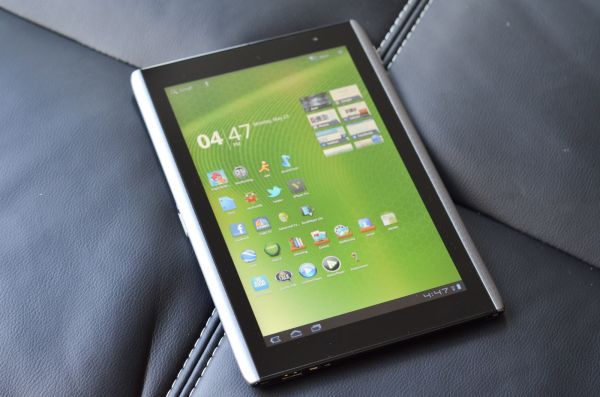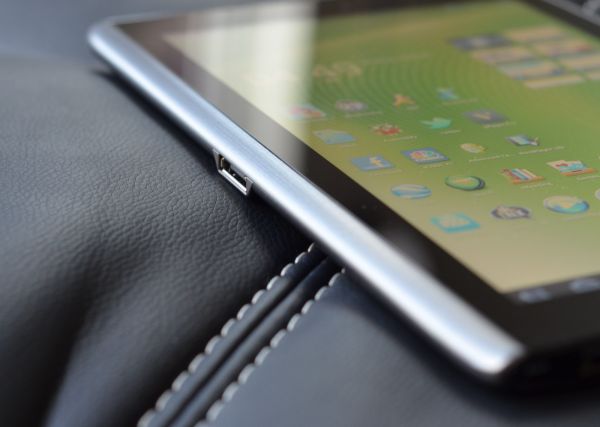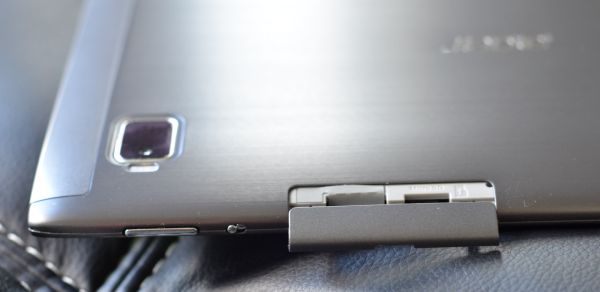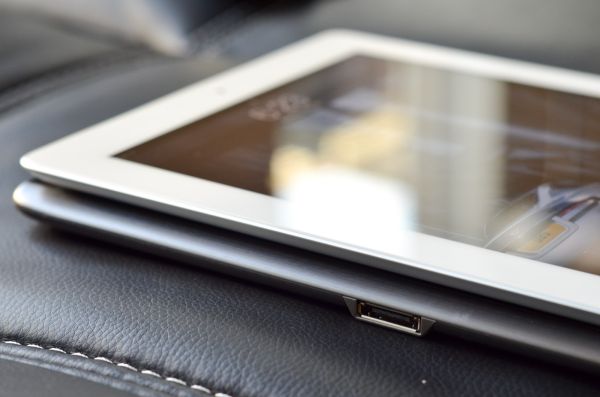Acer Iconia A500 - Honeycomb on a Budget
by Vivek Gowri & Jarred Walton on June 24, 2011 4:00 AM ESTNext in our series of Honeycomb tablet reviews is the Acer Iconia Tab A500. The A500 was the second Honeycomb tablet to go on sale, and is one of four on the market at present, all of which are very similar. They share basic specs—10.1” 1280x800 displays, NVIDIA’s Tegra 2 underhood, 1GB LPDDR2 RAM, 16-64GB onboard NAND, front and rear facing cameras with HD video capture, basic wireless connectivity options, and stock versions of Android 3.0/3.1 Honeycomb (albeit with different preloaded software packages). The hardware similarities makes things like design and price that much more important, and the latter is where Acer seemed to have an edge.
| 2011 Tablet Comparison | ||||||
| Apple iPad 2 |
Asus Eee Pad Transformer |
Motorola Xoom WiFi | Samsung Galaxy Tab 10.1 | Acer Iconia Tab A500 | ||
| SoC | Apple A5 (Dual ARM Cortex A9 @ 1GHz) | NVIDIA Tegra 2 (Dual ARM Cortex A9 @ 1GHz) | NVIDIA Tegra 2 (Dual ARM Cortex A9 @ 1GHz) | NVIDIA Tegra 2 (Dual ARM Cortex A9 @ 1GHz) | NVIDIA Tegra 2 (Dual ARM Cortex A9 @ 1GHz) | |
| GPU | PowerVR SGX 543MP2 | NVIDIA GeForce | NVIDIA GeForce | NVIDIA GeForce | NVIDIA GeForce | |
| RAM | 512MB | 1GB | 1GB | 1GB | 1GB | |
| Display | 1024 x 768 IPS | 1280 x 800 IPS | 1280 x 800 | 1280 x 800 PLS | 1280 x 800 | |
| NAND | 16GB | 16GB | 32GB | 16GB | 16GB | |
| Dimensions | 241.2mm x 185.7mm x 8.8mm | 271mm x 175mm x 12.95mm | 249.1mm x 167.8mm x 12.9mm | 256.6 x 172.9 x 8.6mm | 260 x 177 x 13.3mm | |
| Weight | 601g | 695g | 730g | 565g | 730g | |
| Price | $499 | $399 | $599 | $499 | $449 | |
Long a sales leader in the budget notebook market, Acer jumped into the tablet game with a price advantage—the Iconia A500 came in at $449, in comparison to $499 for the iPad and $599 for the WiFi-edition Motorola Xoom (though it is worth mentioning that the Xoom comes with twice as much onboard storage as the Iconia and iPad). ASUS released the $399 Eee Slate Transformer soon afterwards, but supply issues meant that the Acer was the cheapest readily available Honeycomb tablet for some time. More recently, some retailers have dropped the prices of the Iconia, with MacMall selling it on their eBay store at one point for just $379. On paper, that’s a screaming deal, but most of the time it sells for closer to its $449 MSRP. Outside of pricing, though, how does the Acer hold up in real life?
The Hardware
Since the software and internal components are so similar between devices, the price, design, and screen tend to be the largest differentiating factors, in that order. Alas, the A500’s design isn’t on the same level as Apple, or really anyone else. Of the four Honeycomb tablets right now, the Iconia probably has the weakest design.
Acer’s design team went with the metal-and-glass approach, with an aluminum chassis wrapped around the screen capped by black plastic on both sides. That’s a good way to go on paper—similar designs have been implemented by Apple, Nokia, and HTC to great success. The main benefit is that it allows for nearly seamless construction around the body, as seen in the iPod mini and iPod nano, as well as the Nokia N8 to a lesser extent (the N8 has a more complex design that necessitates some seams for the sloping end-pieces, but the main body has a similar wraparound style).
Unfortunately, Acer lost the plot a little by putting a seam down the top and bottom edges of the device. So much for a unibody construction. As a mechanical engineer, I understand the complexities of manufacturing the entire body as a single part, but it’s the kind of thing that makes a device feel like a premium product. There are some good things going for the Acer here—the design itself is attractive, and the brushed aluminum finish is great (I’d have personally preferred a lighter silver color rather than gunmetal, but still), and little details like the speaker grills look great. But by and large, I see areas where the hardware just doesn’t have the polish of the other big names.
There's minor flex and creaking in various parts of the chassis, large panel gaps (1mm), seams in places you don’t expect to find seams, the SD card door that feels like it might snap at any second, the screen not sitting flush with the aluminum bezel—these are all minor things, but that kind of attention to detail is necessary for any company that wants to seriously challenge Apple from a hardware perspective. Acer also has to contend with ASUS, given that ASUS is currently priced lower and comes with an IPS panel and better overall construction.
At 13.3mm thick, the A500 is definitely on the chubby side—it’s only a hair larger than the Transformer and the Xoom (both at 12.9mm) but significantly thicker than the sub-9mm iPad and Galaxy Tab 10.1. The Iconia is slightly narrower and taller than the Transformer, but both have a larger footprint than the Xoom and Galaxy Tab 10.1. The Iconia matches the Xoom at 730g (1.61lbs) and comes close to matching the 695g Transformer, but none of the Honeycomb tablets can come close to the Galaxy Tab 10.1’s positively anorexic 565g (1.25lb) figure.














45 Comments
View All Comments
VTArbyP - Sunday, June 26, 2011 - link
As usual, it takes me a while to figure out for myself why something becomes a hot. My iPod Touch was a revelation in comparison to the Palm Pilot it replaced. Who knew an MP3 player would become what it is!My view is that tablets are the fulfillment of the promise of a "paperless" society. The User Interface works; much better than any before it. The batteries last long enough, and color / video / 3d abilities give it scope for growth far beyond paper or even e-ink readers. If you read the end of this article, you see that the tablet works best in place of paper, books, web browsing and such. You simply don't need to print much with a tablet around - much more so than with its smaller forebears. Add back a stylus and hand written notes can be easily added. Meanwhile, Asus has the pseudo-netbook NAILED in the eee pad transformer. All the pieces, size, UI and apps, are here for tablets to save the trees and go far, far beyond printing!
When you think of a tablet in this light, you can guess at the future. Tablets will add i/o: 1) to use them as an extra display for your "bigger iron" be it a PC or a game console. 2) to transfer any and all info (work / play / whatever you are doing) to and from PCs / Smart Phones and the Cloud. You may have noticed that display ports have disappeared from new Macs, Thunderbolt will do all data transfer including video. I'd stake good money that the iPad 3 will have Thunderbolt and use it in the way I described.
I haven't even touched on the convertible smart phone / tablets out there or coming soon! Beware though, it's not that one "smart item" will replace what went before, rather that all of them will work together for a complete solution.
Frankly I find this vision of the future almost scary. I'm just glad that I can see a world with little use for paper coming beforehand.
VTArbyP - Sunday, June 26, 2011 - link
Over edited post, sorry folks! Line 1:"becomes a hot." ought to be "becomes Hot." 2nd paragraph: "Add back a stylus and handwritten notes are easy." should replace the "Add back a stylus and hand written notes can be easily added." sentence.ex2bot - Wednesday, June 29, 2011 - link
(A relatively minor point:)Jarred gives his overall take on tablets without ever using the leading tablet and its superior (in size and scope) software library?
In my experience with the iPad 1, I don't use my laptop nearly as much as I used to. Mine is a bit of a special case in that I'm not able to sit at a desk for more than a couple hours due to a disability. The iPad lets me surf the web, read books and magazines (Zinio and Kindle!), play games, and do anything else that doesn't requre lots of typing while lying down. I'm sure the Android tablets have the similar advantages.
I do agree about the gaming being limited. Games tend to need real buttons.
Ex2bot
henryvol - Monday, October 10, 2011 - link
Oct. 6, 2011 After about a week of using my new Acer Iconia A500 the unit developed an issue where the battery would not charge. This was an intermitent trouble whereby at times the unit would charge the battery for a few seconds or maybe a couple of minutes before stopping the recharging process. I used multiple power adapters with the same results from each. I performed a factory reset and a hard reset on the unit but, the resets did not correct the issue.I contacted Acer Support and sent the unit in for repair. I received the A500 back from the repair facility 8 days later still with the battery charging issue. They returned it to me without repairing or correcting the issue.
I contacted Acer Support this morning and again returned the A500 for repair.
After searching some of the Acer A500 forums, I found that other users were experiencing the same issues with their A500 tablets. If the power adapter is connected the battery status indicator indicates 'Discharging' but, the battery percentage stays the same. When the power adapter is removed, the battery percentage indicator begins to decline. When the power adapter is connected, the A500 battery does not charge.
Based on my experiences with this product and the Acer Repair Service, I would not purchase an Acer Iconia A500 again and I would not reccomend this product. Acer Service/Support has not offered to replace my defective A500.
khernau - Friday, March 9, 2012 - link
That looks great! I would love to get something like this. I have an old laptop, but it's not working right now. I need to see about getting some acer repair parts for it. Hopefully it can be fixed!http://www.acerparts.ca